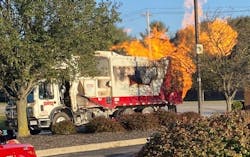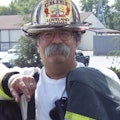Close Calls: Not a Waste—The Tale of a CNG Garbage Truck Fire
“Engine 1 respond to a garbage truck on fire.”
Most firefighters have been alerted to respond to that run, and, almost always, the groans start, because it can be a lengthy—and dirty—operation. However, there is much to such a call, and there is very significant risk. Not only do we have this close call to learn from this month, but, a subject matter expert provides some basic information, so all firefighters and officers can learn.
The department
The City of Mason, OH, Fire Department is a full-time, career fire-EMS/ALS transport department. It protects 33,000 residents and thousands more work commuters and visitors. Within the confines of Mason is the Great Wolf Lodge, Kings Island amusement park and the Western & Southern Open tennis tournament, with Interstate 71 running through the city.
The department staffs two firehouses with an engine company, a ladder (quint) company, three ALS ambulances, a battalion (deputy chief) shift commander and an ALS nontransport unit. Each firehouse is staffed continuously by firefighter/paramedics and a company officer.
The department has 12–15 personnel per shift, responding to approximately 4,500 runs annually. A first-alarm assignment brings in automatic mutual aid box-alarm-type response regionally, and the department provides similar response to neighboring jurisdictions. On average, 30–40 firefighters are due to first-alarm building assignments through collaborative efforts.
The local refuse and recycling company (the truck of which was involved in the incident that’s discussed in this column) is Rumpke Waste and Recycling, which provides residential and commercial trash and recycling services to Indiana, Kentucky, Ohio and West Virginia. The company has operated for nearly 90 years. It partners with many of the fire departments in the region to provide training as well as cooperation, assistance and support during emergencies.
Sincere thanks to all of those who assisted with this column, including: City of Mason Fire Department Fire Chief Bryan Brumagen, Deputy Fire Chief Todd Day (shift commander), Lt. Jason Graham and Lt. Nate Wyatt; the responding Deerfield Township Engine 56 firefighters; and Rumpke Waste and Recycling’s Justin Pyle, Mark Richter and Dave Weisinger. Special thanks to Chief Bob Norton, who is an active firefighter, past chief in Connecticut and the general manager for All-Waste, for sharing his knowledge about these types of fires.
Account from Graham & Wyatt
Ladder 52 (a quint) was dispatched by Warren County Communications to the intersection of Western Row Road and Mason-Montgomery Road, near the entrance of a church parking lot for a possible vehicle fire. Upon arrival, they found a garbage truck with its contents on fire, with visible smoke and fire. Crews stretched a 1¾-inch hoseline for extinguishment and requested that the driver of the garbage truck dump his contents onto the street. The driver was unable to do so because of mechanical problems.
The driver of the garbage truck was very cooperative and immediately notified the arriving firefighters that the truck was powered by compressed natural gas (CNG). (This vehicle was converted to CNG, therefore the location of the tanks wasn’t clear, although CNG hazmat signs were visible on the vehicle.) The driver also summoned his company’s safety personnel to respond.
Ladder 52 requested an additional engine for staffing and water supply, and nearby Deerfield Township Engine 56 was dispatched. Upon arrival, Engine 56 supplied Ladder 52 from a hydrant. Ladder 52 set up its aerial device to attack fire from the top, because the handline was unable to access the opening to the area that was on fire.
The fire only was getting knocked down partially because of the deep-seated debris and limited access. At this point, Day arrived and assumed command. It also should be noted that the Rumpke safety personnel were en route.
The garbage truck driver stated that the CNG tanks were in the rear lift gate of the truck, and only cardboard recycling was collected on his route. The driver advised that he wasn’t able to dump his load, because a sensor that was located on the top of the truck burned.
After about 45 minutes, the fire was getting knocked down with copious amounts of water but definitely wasn’t extinguished. Ladder 52 still was set up to the rear of the truck, flowing its aerial master stream into the small opening that was on top of the truck. The effect of Ladder 52’s aerial was minimal because of the size of the opening and the position of the push blade.
About an hour into the response, the garbage truck driver (in cooperation with the fire department) attempted to start the truck to move it, so the load could be dumped. However, the garbage truck wouldn’t start. CNG was then shut down to the rest of the vehicle. Ladder 52 was moved away from the rear of the garbage truck. (There was concern of Ladder 52 being an exposure if the CNG tanks burst.) The aerial was set up again.
The corporate safety advisors arrived on scene with additional information. Per the company, the CNG tanks were designed to bleed off at 220 degrees F (burst discs). However, according to the thermal imaging camera, the temperature of the load area of the garbage truck exceeded 800 degrees F. Rumpke corporate personnel stated that it was better to let the vehicle burn and vent off while all personnel stayed back. Ladder 52’s crew cleared the area and kept the road shut down until the CNG tanks self-vented via a large fire-involved blow-off. Heat from the venting was massive and caused damage to the asphalt driveway and the exposed church sign.
Once the CNG bled off, a much more stable content fire remained, and foam was used to extinguish the remainder of the flames.
Comments from Chief Goldfeder
The objectives are that we protect the exposures, that nothing “blows up” and that no one gets hurt. All refuse companies will agree with that.
Remember, although CNG can’t BLEVE, a CNG tank can fail under extreme pressure. Furthermore, although CNG is odorless, it has mercaptan added to it, so CNG can be detected. An on-board computer system manages the CNG flow into the engine.
The CNG tanks might be behind the cab, on the roof or in the tailgate area. The tanks are made to similar standards, just as SCBA bottles are. Pressure relief devices (PRDs) are located in the valve stem and on opposite sides of some tanks.
There might be a “CNG” decal on the rig to show the company’s commitment to the environment.
Unlike with propane tanks, CNG vehicle PRDs are temperature-activated and remain open once activated. The eutectic material melts at 219 degrees F, which permits the gas to escape through vent tubes.
Causes of these fires include load fires, hydraulic oil fires, electrical fires, brake-overheating, circumstances that are related to fuel and external contact from outside electrical sources.
When operating, fight the fire but don’t cool the tanks. The latter only will delay the functioning of the vent system. When cooling, use unstaffed appliances, such as ladder pipe, deck gun or portable master stream. Don’t cool PRDs. The tanks might overheat. PRDs wouldn’t “feel the heat” and, thus, won’t activate.
Secure/evacuate a 500-yard perimeter, starting in the direction of the path that a CNG tank would travel. Use apparatus as a shield for staged personnel.
In conducting research for this piece, I contacted Past Chief Bob Norton from All-Waste, which has about 50 CNG-fueled trucks in its fleet. He developed some general firefighter training tips.
Load fires are the most common type of truck fire in the refuse and recycling industry. Often, there is little evidence of a fire problem until the material is dumped into the back of the garbage truck and air is introduced—simply by driving down the street. A small smoldering fire (unknown to the driver) can be fanned to become a free burning fire problem. Once ignited, the safest way to extinguish the fire is to dump the load onto the ground and allow the firefighters to hose down the burning refuse.
As we learned in the Mason department’s case, many new garbage trucks have the added complication of being fueled by CNG for efficiency and environmental reasons. These vehicles are engineered to be extremely safe, but load fires can heat the CNG storage tanks, raise pressure and cause them to “off-gas”—thus, the reason to discharge any load fire as soon as possible when possible.
According to Norton, “If it’s a lost cause, try putting out the load fire inside the body, but don’t attempt to cool the tanks, as all you’ll do is keep the PRDs cool and nonfunctional.” As we saw in this case, Mason firefighters tried to eject the load that was in the garbage truck, but because of damage to the system, it wouldn’t unload.
Nearly all refuse and recycling companies have a corporate safety division. Furthermore, they often have training programs that are available for firefighters. Now would be a great time to reach out to them. Share this piece with them and ask for a hands-on training session, so your members can learn first-hand what to do and not do when you respond to and operate at these types of fires.
Lessons Learned/Reinforced
In discussions with the officers of the City of Mason, OH, Fire Department who were dispatched to a call of a compressed natural gas-powered (CNG) garbage truck that was on fire, the following was shared:
- Upon arrival, place apparatus away from the rear of the garbage truck—as with all vehicle fires—at angles and at a distance where the rig doesn’t become an exposure
- Immediately communicate with the driver of the garbage truck as part of your size-up to determine CNG info, tank levels/location, etc.
- Use your thermal imager to determine fire location and temperature; in this case, one of the officers indicated that the garbage truck was reading in excess of 800 degrees F on a thermal imager, although the system was designed to vent at 220 degrees F; the situation was beyond doing any “cooling”
- Dump the load immediately if it can be done
- If the load can’t be dumped, let the garbage truck system do its job and let it burn, while protecting all exposures and, of course, department personnel and civilians
- Work with corporate safety personnel in person or by phone and use their input in decision-making
About the Author
Billy Goldfeder
BILLY GOLDFEDER, EFO, who is a Firehouse contributing editor, has been a firefighter since 1973 and a chief officer since 1982. He is deputy fire chief of the Loveland-Symmes Fire Department in Ohio, which is an ISO Class 1, CPSE and CAAS-accredited department. Goldfeder has served on numerous NFPA and International Association of Fire Chiefs (IAFC) committees. He is on the board of directors of the IAFC Safety, Health and Survival Section and the National Fallen Firefighters Foundation.

